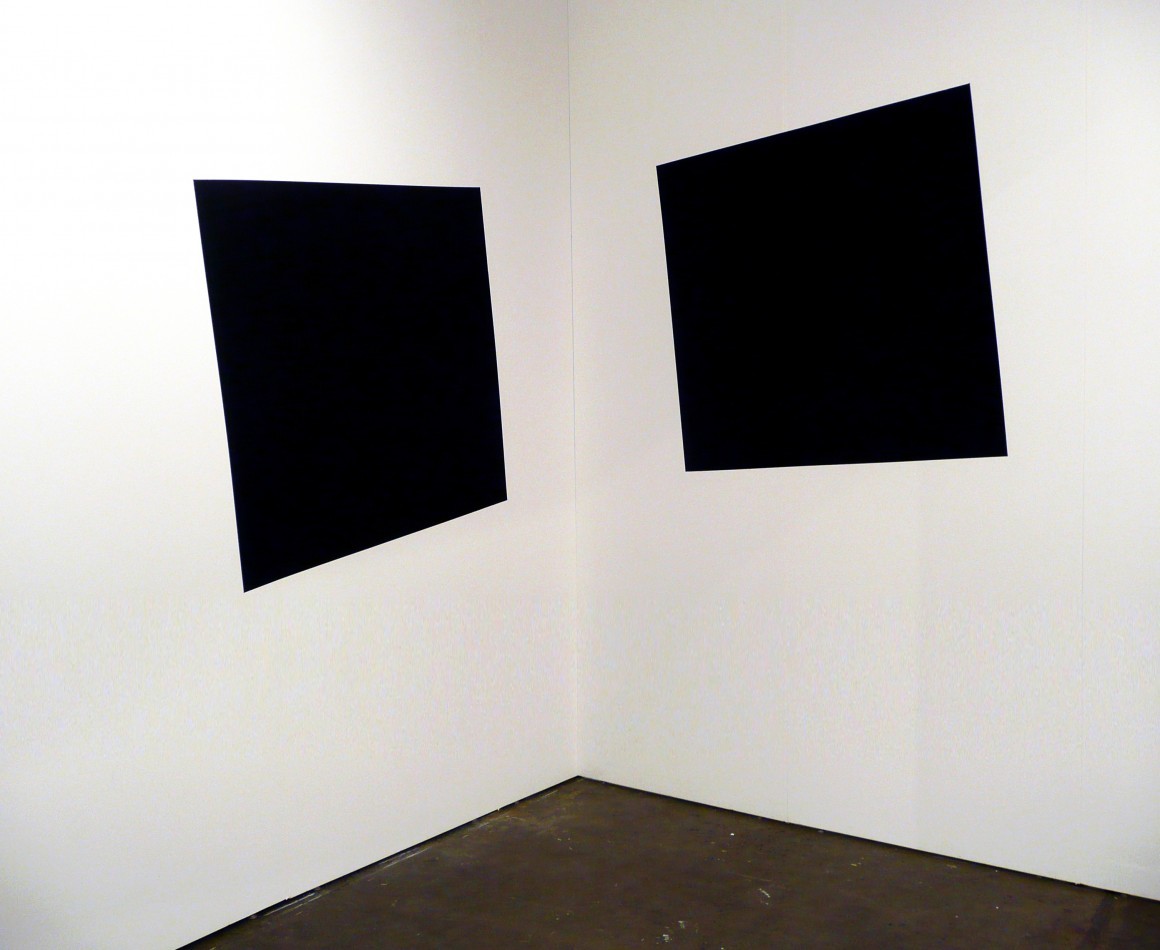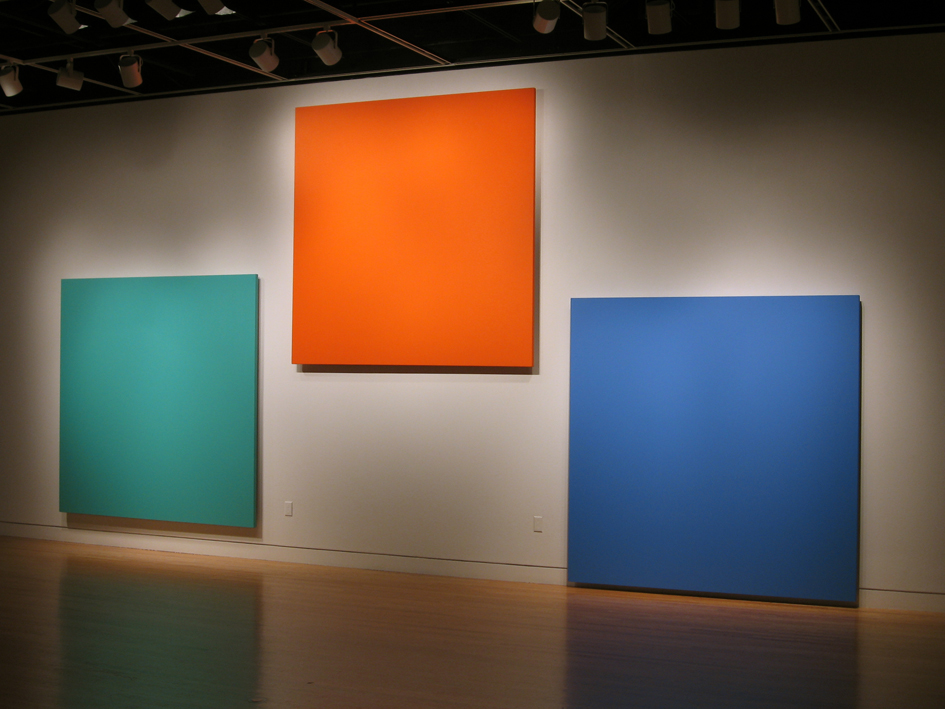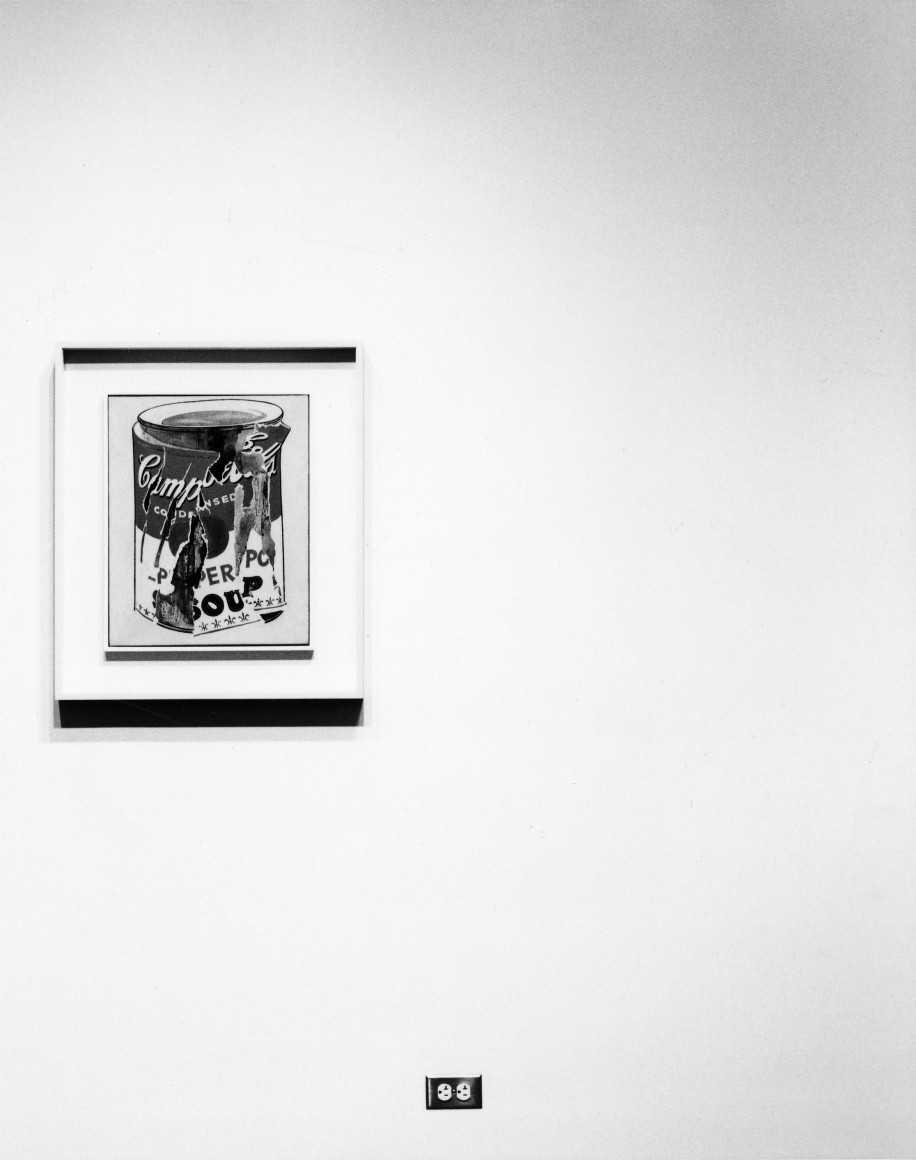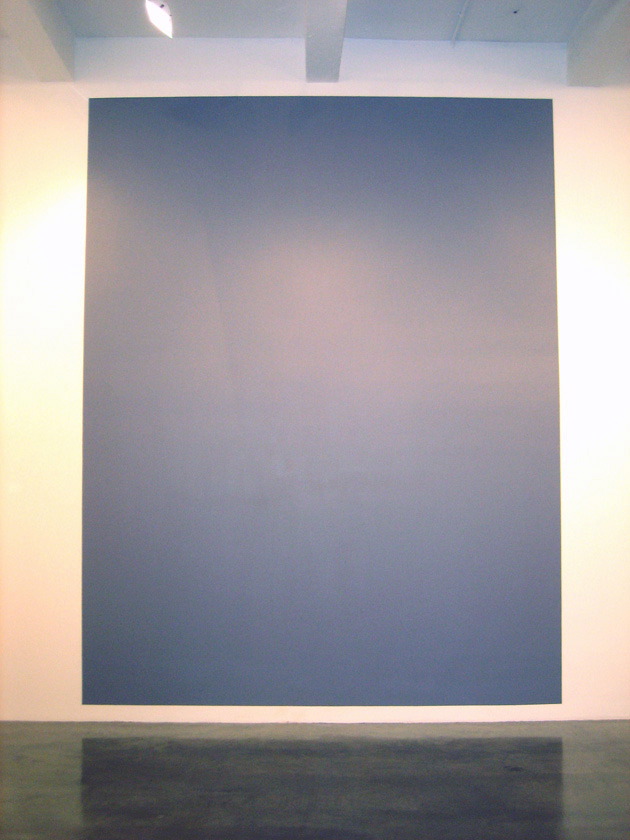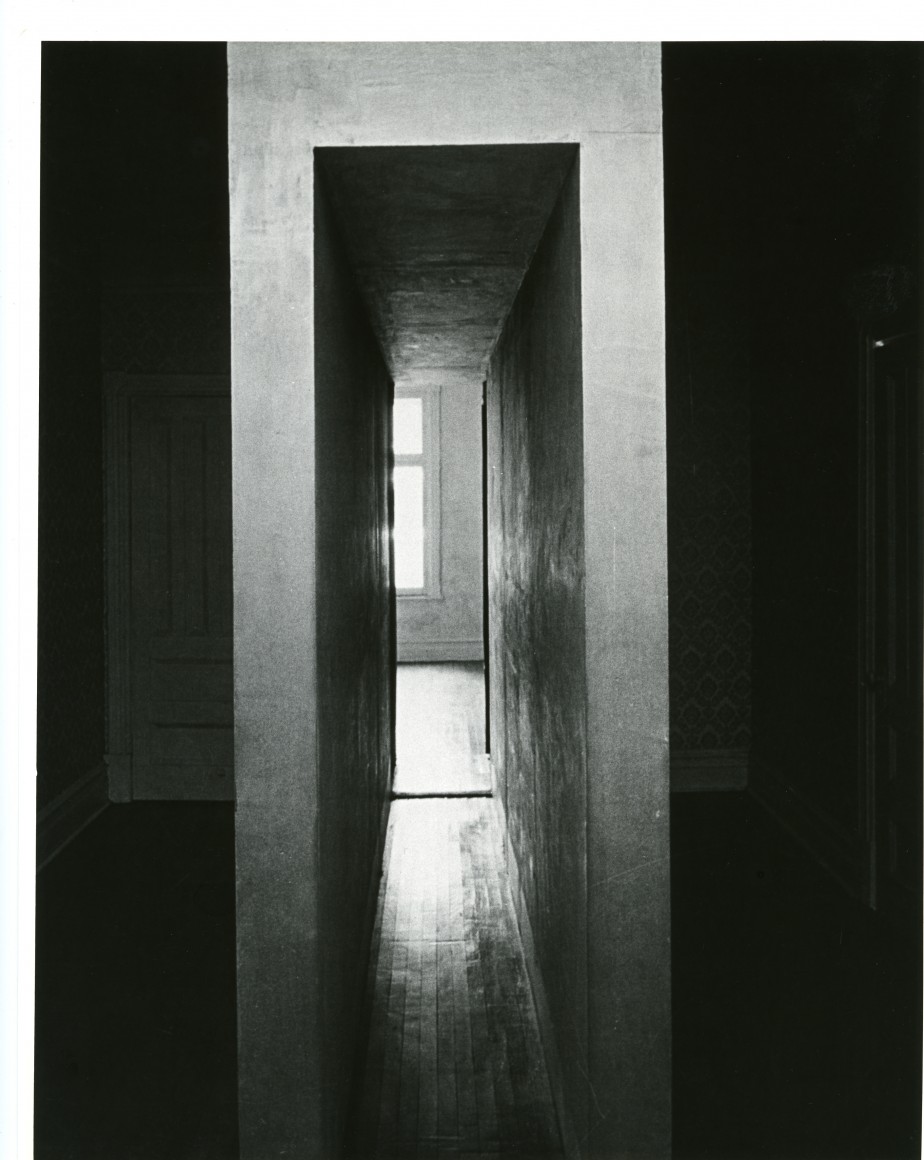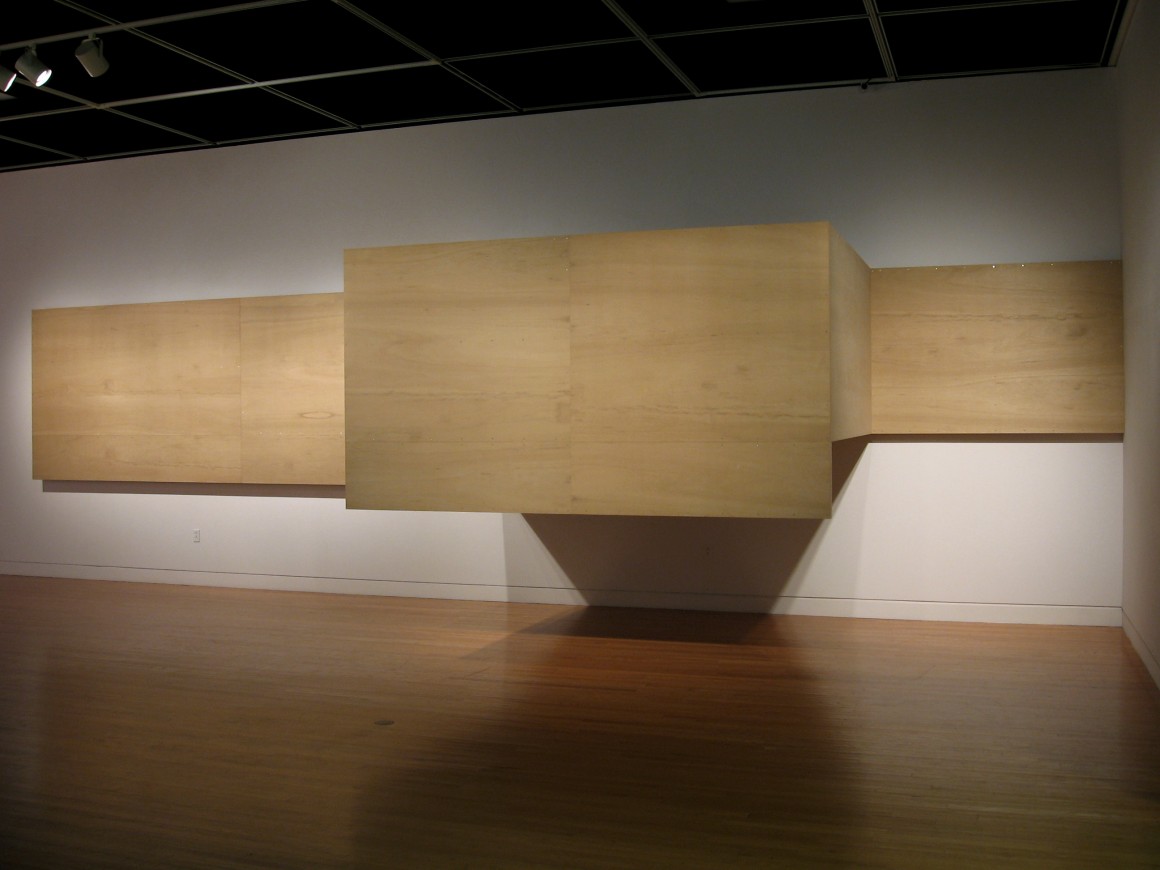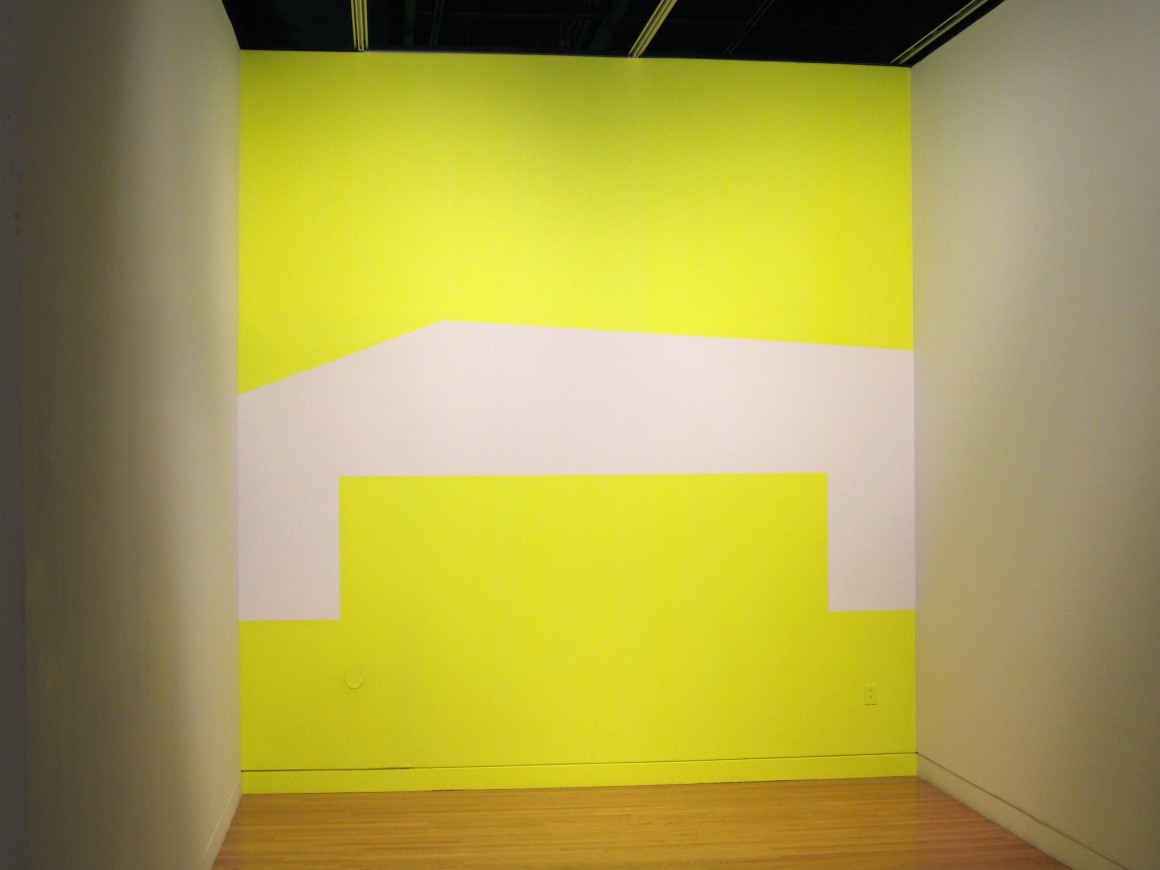In this exhibition the painter Pierre Dorion examines the relationship between the artist and the wall as a flat, pictorial or sculptural surface or, rather, as a conceptual reference, a site for questioning, or as material that informs the imaginary. Invited artists invest the walls of the Gallery by intervening directly on them either pictorially, as is the case with Neil Campbell, Louise Lawler, Barry Allikas and Wanda Koop or sculpturally by developing an ensemble that projects into space, in the case of by Alexandre David’s work. A series of monochromes by Claude Tousignant hover between the two categories. Michael Merrill, graphically deconstructs the gallery’s space in a series of drawings while Guy Pellerin deploys his pictorial intervention in an area where the public space of the atrium meets the white cube of the Gallery. A work by Betty Goodwin and documentary photographs by Gabor Szilasi depict her Mentana Street Project of 1979, in which she transformed an apartment by marking its wall surfaces and creating a structure of corridors. Through and beyond these various manners of working off the wall various issues arise concerning the representation of the exhibition site and its context, the residual presence of both abstract painting and Minimalism, a particular history of painting and of installation in Montreal, and, indeed, a global political consciousness.
Produced with the support of the Frederick and Mary Kay Lowy Art Education Fund.
A project by Pierre Dorion
Exhibition produced by the Leonard and Bina Ellen Art Gallery with the support of the Canada Council for the Arts
THE ARTISTS
I am self-taught and have been exhibiting my work since 1979. I have engaged in ceramics, installation, sculpture, performance, music and film, not to mention assorted species of painting. 15 years ago I decided to devote myself to hard-edge painting.
I begin with chance. Through various processes of selection and mutation, I arrive at a viable synthesis of order and the original randomness. Researchers say that life exists at the edge of order and chaos. My paintings like to live on that border, and on others as well, for example organic/inorganic, depth/flatness, abstract/figural.
THE WORK
Bridge (For Blinky Palermo), 2009
Latex paint and fluorescent pigment.
Courtesy of the artist and Division Gallery, Montréal.
Blinky Palermo was an orphan with an assumed name. His work often exists between disciplines and his artistic trajectory can be seen as straddling minimalism and what came after. His painting, Blaue Brücke, was produced in 1964-65. For this exhibition I have abandoned my normal working method, retaining the basic form of Palermo’s original piece but changing the colour and adapting it to the present architectural setting, thereby anticipating, in retrospect, a move he was soon to perform himself.
EXPLORE
- the significance of painting directly on the wall and the role that this plays in this work;
- the ways in which this work addresses historical antecedents.
ADDITIONAL SOURCES OF INFORMATION
Barry Allikas. Centre for Canadian Contemporary Art: The Canadian Art Database. Web. 21 oct. 2009.
Lamarche, Bernard. Oz at Sylviane Poirier. Le Devoir 15 and16 Nov. 2003. Print.
Milar, Joyce. Place à la Peinture / Just Painting: Barry Allikas, David Blatherwick, David Elliott, Michael Merrill. Pointe Claire: La galerie d’art Stewart Hall Art Gallery, 2002.
Skene, Cameron. Barry Allikas: Event Horizons. Canadian Art Online. Web. 21 Oct. 2009.
CloseNeil Campbell, a native of Saskatchewan, studied at the School of the Museum of Fine Arts in Boston and the Vancouver School of Art. He received an MFA degree at Concordia University, Montreal in 1979. Following 15 years of residence in New York City he relocated to Vancouver, where he currently lives and works. His practice centres on painting and has been presented in group and solo exhibitions throughout North America and Europe.
In my pursuit of making pictures, I find myself intrigued by the construction of ’pictorial space’. I am interested, as well, in ‘talking to the body’. I aim to devise images that may lead the viewer to reflect on the process of viewing and, to experience a degree of somatic response– a sensation of some kind that will lead the viewer to an awareness of the body or what I think of as the ‘vehicle of perception’.
THE WORK
Hey Kasimir!, 2009
Latex paint.
Courtesy of the artist and Blanket Contemporary Art, Vancouver.
In Hey Kasimir! I have registered the image on two adjoining walls that meet at right angles. Due to the unique composition of this image, as viewers move through the room their attention may be drawn to the conspicuous shifts in perspective that can be perceived as they alter their point of vantage. Because the image is scaled and positioned in a precise relationship to the given location, the viewer may also be mediation to some awareness of the contextual space. The dimensions of the work are given as the dimensions of the two walls on which the work is painted. Each time the work is realized, the dimensions vary according to the configuration of the given site.
EXPLORE
- the ways in which this work directly addresses the architecture of the gallery and the reasons why this is important;
- humour and what it reveals in this reference to and play on Kasimir Malevich’s Black Square.
ADDITIONAL SOURCES OF INFORMATION
Arden , Roy. Supernatural: Neil Campbell, Beau Dick. Vancouver: Contemporary Art Gallery, 2004.
Heartney, Eleanor. Neil Campbell at Andrea Rosen. Art in America 80 (1992): 135.
Nasgaard, Roald. Abstract Painting in Canada. Vancouver: Douglas & McIntyre; Halifax: Art Gallery of Nova Scotia, 2007.
Szewczyk, Monica, ed. Paint: a psychedelic primer. Vancouver: Vancouver Art Gallery, 2006.
CloseAlexandre David lives and works in Montréal. He mainly works in the field of sculpture, and his projects often relate to architecture. His work has been shown in various museums and galleries in Canada, the United Kingdom, the Netherlands and France. He has exhibited his work in solo exhibitions at Optica and Dare-Dare in Montreal and La Chambre Blanche in Quebec City in 2007 and, in 2009, at Aceartinc in Winnipeg and Grunt in Vancouver. In 2009, he also took part in the show Base Camp at Truck in Calgary.
Our everyday architectural sensations are a necessary background for my work in sculpture. I don’t reference architecture as a subject, but I make work that relies on the way we walk through doorways with ease, walk alongside walls, turn corners and sit on benches for example. Some of my works are made to move around in while others aim to create an architectural sense of space through the experience of a self-contained object. I approach my work in the context of our collective understanding and transformation of architecture, but I don’t wish to comment the use or misuse of our built environment through my work. Rather, I try to generate specific experiences that may subsequently affect, in a small way, how we use space in our everyday lives.
THE WORK
untitled, 2009
Wood and plywood.
Courtesy of the artist.
When we stop in front of an object to look at it, sometimes our mind keeps on moving along the object’s surface, and we imagine ourselves looking at the object from another point of view. I was thinking about such an experience, which is a very common one, when I was making this work. My aim here was to create an architectural sense of space in a self-contained object, through real movements as well as imaginary ones.
EXPLORE
- the nature of and the limits of space and their importance in the consideration of this work which transforms our sense of space as well as actually physically transforming the gallery space;
- objects and the built environment and the various ways in which this work refers to these.
ADDITIONAL SOURCES OF INFORMATION
Fraser, Marie. La demeure. Montréal: Optica, 2008.
Godmer, Gilles. Alexandre David. Montréal: Musée d’art contemporain de Montréal, 2002.
Paris, Chantal T. Alexandre David: Penser l’espace. Espace no. 81 (2007): 39.
Tousignant, Isa. Woodworkers: Alexandre David, Stéphane La Rue and Québec’s new minimalism. Canadian Art 25.1 (2008): 44-48.
CloseBetty Goodwin was born in Montreal in 1923. She explored a variety of media including printmaking, painting, sculpture, and drawing. Her work has been the subject of numerous exhibitions and can be found in public and private collections. Goodwin died in 2008.
THE WORKS
The Mentana Street Project, 1979
Photographs by Gabor Szilasi, 1979.
Four Columns to Support a Room, No. 3 (The Clark Street Project), 1977
Oil on gelatin silver prints.
Private collection.
From 1977 to 1983, Goodwin explored the theme of passage in her installation work. In this work, Goodwin created interior walls, rooms and passageways with various materials. This series of installations included The Clark Street Project and The Mentana Street Project.
EXPLORE
- surface and dimensionality;
- the relationships that exist between the space depicted in the documentation of this work and the gallery space. How is this work transformed by its presentation via documentary photographs?
ADDITIONAL SOURCES OF INFORMATION
Bélisle, Josée. Betty Goodwin : parcours de l’œuvre à travers la collection du Musée d’art contemporain de Montréal. Montréal : Musée d’art contemporain de Montréal, 2009.
Bradley, Jessica and Matthew Teitelbaum eds. The Art of Betty Goodwin. Vancouver: Douglas & McIntyre; Toronto: Art Gallery of Ontario, 1998.
Paikowsky, Sandra. Betty Goodwin: Passages. Montréal: Concordia Art Gallery, 1986.
Tovell, Rosemary L. The Prints of Betty Goodwin. Vancouver: Douglas & McIntyre; Ottawa, The National Gallery of Canada, 2002.
CloseWanda Koop’s painting career spans three decades and includes over 50 solo exhibitions. Her work is included in numerous international private and museum collections including the National Gallery of Canada, which together with the Winnipeg Art Gallery, is preparing a major exhibition of Koop’s work. She is the recipient of numerous awards, including Doctors of Letters from the University of Winnipeg, and the Emily Carr Institute of Art and Design, as well as a Doctor of Laws from the University of Manitoba. She is a Member of the Order of Canada, and founder of Art City, an inner city art centre in Winnipeg.
THE WORK
LOOKUP, 2009
Acrylic on canvas, 42 elements.
Courtesy of the artist.
Three walls of the gallery are painted a very pale grey, ephemeral blue. There are forty-two painted panels, each 25×76 cm (8″x10″), all acrylic paint on floating edge canvases. The canvases are monochromes, ranging in colour from subtle hazy green pink, to deep black ultramarine blue, to brilliant fluorescent orange. This work represents my many years of ongoing colour research and reveals how colour can translate and affect experience.The painted panels are installed on three walls at various heights and random spacing, referencing digital breakup. These panels become Illusory fragments of a giant pixelated image and appear to float away from the walls. The completed installation becomes one very large painting I call LOOKUP.
EXPLORE
- the visible;
- the ways in which this work recasts the space in which it is exhibited.
ADDITIONAL SOURCES OF INFORMATION
Enright, Robert. The Beauty of Longing: A Conversation with Wanda Koop. Border Crossings Magazine, Fall (1996), 12-23.
Enright, Robert, and Wanda Koop. Wanda Koop: In Your Eyes. St. Norbert: St. Norbert Arts Centre, 2001.
Halkes, Petra. Aspiring to the Landscape: On Painting and the Subject of Nature. Toronto: University of Toronto Press, 2005.
Koop, Wanda. Sightlines. Regina: MacKenzie Art Gallery, 2002.
CloseLouise Lawler was born in 1947 in Bronxville, New York. She completed a BFA at Cornell University in 1969. Lawler’s work is mainly photographic and explores important questions that define art such as context, value, meaning, use, reception, and memory. She lives and works in New York City.
THE WORKS
No Charges Filed, 2008
Latex paint.
Courtesy of the artist and Metro Pictures, New York.
A wall can be a location for specific attention. “No Charges Filed” evolved from the specific architecture of Metro Pictures in New York and a New York Times article. Taking the wall that is seen on entry, the place of prominence, replacing it with a neutral grey that could be felt as a void yet full of connotations (‘file cabinet’, ‘battleship’, ‘minimal grey’); a matter of taking and deflecting attention. The newspaper article that informs the work is in reference to a prisoner held at Guantanamo Bay and released without any charges ever brought against him. The article is available at the attendant’s desk and here.
Soup Can, 2006/2007
Black and white photograph.
EXPLORE
- the means by which Soup Can questions ideas such as history, value, and meaning in art;
- the subtle and unusual devices used in No Charges Filed to address the troublesome question of the plight of prisoners at Guantanamo Bay.
ADDITIONAL SOURCES OF INFORMATION
Eklund, Douglas. The Pictures Generation, 1974 – 1984. New York: The Metropolitan Museum of Art; New Haven and London: Yale University Press, 2009.
Kaiser, Phillipp, ed. , Louise Lawler and Others. Ostfildern-Ruit: Hatje Cantz Verlag; Basel: Kunstmuseum Basel, 2004.
Miller-Keller, Andrea , and Stephen Melville. Louise Lawler: The Tremaine Pictures. Geneva: BFAS Blondeau Fine Art Services;
Zürich: JRP|Ringier, 2007.
Molesworth, Helen, ed. Twice Untitled and Other Pictures (looking back). Columbus: Wexner Center for the Arts, 2006.
CloseBorn in Montreal, Michael Merrill has been painting and exhibiting since 1975. He has exhibited both nationally and internationally. He has shown his work recently in Cologne, Germany, and at the Quebec Triennial. He is currently preparing an exhibition of site specific paintings for an exhibition at the Montreal Museum of Fine Arts in spring 2010.
In 1999, I began making paintings depicting aspects of the art world. This series titled Paintings about Art, looks at art in the same way as a still life. The paintings depict art in various locations, from artists’ studios, to storage facilities, to art galleries, to personal collections, to museum exhibitions, etc. I am interested in looking at art and how it is defined by context. Dan Flavin’s fluorescent fixtures are invested with completely different meanings because of context, whether it is a hardware store or a museum. Art in its context can be either homogenous or jarring and it is this point of transformation that interests me. My paintings offer a multifaceted view of a world within the world. One painting, Crate with Dan Graham Sculpture (C.C.A.), shows a Dan Graham work during installation at the Canadian Centre for Architecture in Montreal. The painting depicts the piece halfway between transportation and exhibition. Recently the focus of my work has shifted more towards architecture and relationships to space.
THE WORKS
Gallery 1 – 6, 2009
Silverpoint drawing on panel.
Gallery 6 -1 (version), 2009
Pencil on mylar.
These drawings depict the Gallery as a transparent crystal. Wikipedia defines a crystal as solid material whose constituent atoms, molecules, or ions are arranged in an orderly repeating pattern extending in all three spatial dimensions. My drawings are based on photographs and memory. I use rulers and crude measurements to enlarge an image from a photograph. At a certain point in the drawing process I start to play with line, inverting the visual logic of space.
EXPLORE
- architectural drawing and the ways in which this work is both similar to and different from this type of drawing;
- memory and reflexivity and the roles they both play in these works that are based on images of the gallery in which they are exhibited.
ADDITIONAL SOURCES OF INFORMATION
Bellemare, Roger. Michael Merrill. Montréal: Galerie Roger Bellemare, 2007.
Campbell, James. Michael Merrill: Galerie Roger Bellemare, Montreal. Canadian Art 24.2 (2007): 99-100.
Milar, Joyce. Place à la Peinture / Just Painting: Barry Allikas, David Blatherwick, David Elliott, Michael Merrill. Pointe Claire: La galerie d’art Stewart Hall Art Gallery, 2002.
Simon, Éric. Michael Merrill. Drawings / Dessins. Saint-Hyacinthe: EXPRESSION, Centre d’exposition de Saint-Hyacinthe, 2002.
CloseBorn in 1954 in Sainte-Agathe-des-Monts, Guy Pellerin hols a baccalauréat en arts visuels from Université Laval (Québec) and a Master’s degree from the Massachusetts College of Art and Design (Boston). He lives and works in Montreal. His work is exhibited regularly in Canada, as well as in Europe and the United States. The National Gallery of Canada, the Musée national des Beaux-Arts du Québec, the Musée d’art contemporain de Montréal, the Musée d’art de Joliette, the Musée régional de Rimouski, the Canadian Cultural Centre in Paris, the Southern Alberta Art Gallery, and the Liane and Danny Taran Gallery at the Saidye Brofman Centre for the Arts have all presented important solo exhibitions of Guy Pellerin’s work. He received the Joseph S. Stauffer prize through the Canada Council for the Arts in 1993, the Prix Louis-Comtois in 2000, and the Prix Ozias-Leduc in 2004.
While at first glance the painter’s practice appears fundamentally abstract, belonging to a conceptual tradition of the monochrome, it activates a spectrum of references. Guy Pellerin’s work is articulated around colour. as a reference point, as a persistent memory of a place or an individual. As if colour and its specific texture, like an archaeological memory, was able to describe or reproduce samples.
THE WORK
n° 41 / n° 42 – gris brume, 1981
Polyurethane enamel, latex, cotton canvas. 2 elements.
Courtesy of the artist.
I completed this work using two recycled door frames onto which I stretched canvas. These were placed on trestles and painted in a horizontal position in order to create paint deposits producing the mirrored effect of a frozen lake.
EXPLORE
- this artist’s use of the gallery’s large vitrine and the ways in which this work and its presentation coincide with or diverge from our general understanding of the purpose and use of such a space;
- colour, its importance and its function in this work.
ADDITIONAL SOURCES OF INFORMATION
Cousineau-Levine, Penny. Ailleurs: carte grise a Pierre Dorion. Montréal: Dazibao, 2000.
Lacroix, Laurier. Guy Pellerin: la couleur d’Ozias Leduc. Joliette : Musée d’art de Joliette, 2004.
Lamarre, André. La promesse de la couleur: Guy Pellerin / The promise of colour: Guy Pellerin. Parachute 91(1998): 41-43.
Thériault, Michèle. D’après le dépeupleur/After the Lost Ones: Guy Pellerin, Smith/Stewart, Jana Sterbak, David Tomas. Montréal: Galerie de l’UQAM, 2002.
CloseClaude Tousignant was born in Montréal in 1932. He is a central figure in the development of geometric abstraction in Québec and Canada. His work has been the subject of numerous exhibitions here and abroad and has been acquired by major collecting institutions.
THE WORK
untitled, 2009
Acrylic on canvas, 3 elements.
Courtesy of the artist.
In this work, Tousignant probes the relationship between colour, light, and space.
EXPLORE
- the relationships that exist between colour, space, surface, temporality, and sensation in this work;
- the perceptual effects of this work and the ways in which these might influence the viewer’s experience of the work itself and the exhibition space.
ADDITIONAL SOURCES OF INFORMATION
Campbell, James D. Claude Tousignant: monochromes, 1978-1993. Québec: Musée du Québec, 1994.
Corbeil, Danielle. Claude Tousignant. Ottawa: The National Gallery of Canada, 1973.
Gagnon, Paulette, Mark Lanctôt, and Marc Mayer. Claude Tousignant. Montréal: Musée d’art contemporain de Montreal, 2009.
Thériault, Michèle. 3 Paintings, 1 Sculpture, 3 Spaces. Claude Tousignant: Black, Grey, White. Montréal: Leonard & Bina Ellen Art Gallery, 2005.
Close






